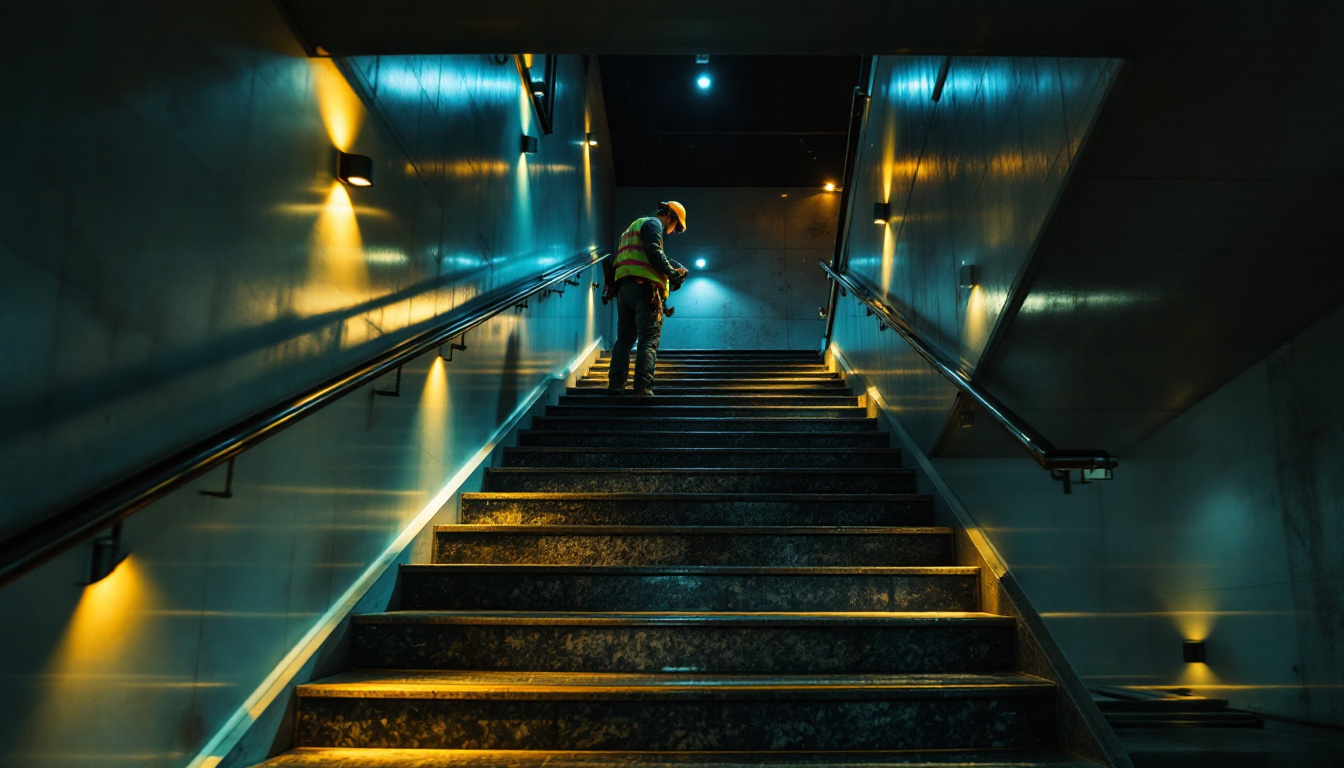
Lighting For Stairs: How Lighting Contractors Can Avoid Issues
Stairways are often overlooked when it comes to lighting design, yet they play a crucial role in the safety and aesthetic appeal of a space. Proper lighting for stairs not only enhances visibility but also adds to the overall ambiance of a home or commercial building. For lighting contractors, understanding the nuances of stair lighting is essential to avoid common pitfalls and ensure client satisfaction.
Stairs can pose significant risks if not properly illuminated. Poor lighting can lead to accidents, falls, and injuries, making it imperative for lighting contractors to prioritize safety in their designs. Adequate stair lighting serves multiple purposes that go beyond mere visibility.
One of the primary reasons for installing effective lighting on stairs is safety. A well-lit staircase allows individuals to see each step clearly, reducing the likelihood of missteps. This is particularly important in homes with children or elderly residents, as they may be more vulnerable to falls.
In commercial settings, the stakes are even higher. Businesses can face liability issues if a customer is injured due to inadequate lighting. Thus, contractors must ensure that stair lighting meets safety standards and regulations. Additionally, incorporating motion-sensor lighting can further enhance safety by automatically illuminating the stairs when someone approaches, ensuring that the path is always visible without the need for manual switches.
Beyond safety, lighting can significantly enhance the aesthetic appeal of staircases. Thoughtfully designed lighting can highlight architectural features, create focal points, and contribute to the overall design theme of a space. For contractors, this is an opportunity to showcase creativity and elevate the client’s experience.
Incorporating various lighting techniques, such as accent lighting or wall-mounted fixtures, can transform a mundane staircase into a stunning visual element. This not only satisfies the client’s aesthetic desires but also adds value to the property. Moreover, the use of color temperature can set the mood; warmer tones can create a cozy atmosphere, while cooler tones can lend a modern and sleek feel. The strategic placement of lights can also guide the eye along the staircase, making it a seamless part of the overall interior design.
Furthermore, integrating smart lighting systems can provide homeowners with the flexibility to adjust brightness and color according to their preferences or needs. These systems can be programmed to change throughout the day, enhancing the ambiance and functionality of the space. By blending safety and aesthetics, contractors can deliver stair lighting solutions that not only protect but also inspire and delight those who use the stairs.
Despite the importance of stair lighting, several challenges can arise during installation. Understanding these potential issues can help lighting contractors avoid costly mistakes and ensure a successful project.
One of the most common issues contractors face is inadequate light levels. Insufficient lighting can create dark spots, making it difficult for individuals to navigate stairs safely. To avoid this, contractors should consider the overall brightness of the space and the specific requirements for stair lighting.
Using a combination of ambient, task, and accent lighting can help achieve the desired light levels. Additionally, selecting the right type of bulbs—such as LED or incandescent—can make a significant difference in brightness and energy efficiency. It’s also worth noting that the color temperature of the bulbs can influence visibility; warmer tones may create a cozy atmosphere but can sometimes obscure details, while cooler tones enhance clarity and sharpness, making them ideal for safety-focused areas like staircases.
Another challenge is the placement of light fixtures. Poorly positioned lights can create shadows or glare, detracting from the overall effectiveness of the lighting. Contractors should take the time to assess the layout of the staircase and determine the optimal locations for fixtures.
Design considerations, such as the style of the fixtures and their compatibility with the surrounding décor, are also crucial. A cohesive design will not only enhance functionality but also contribute to the overall aesthetic appeal of the space. For instance, pendant lights can add a touch of elegance to a grand staircase, while recessed lighting offers a sleek, modern look that minimizes visual clutter. Moreover, incorporating dimmable options can provide flexibility, allowing homeowners to adjust lighting levels based on the time of day or occasion.
Lighting contractors must also be aware of local building codes and regulations regarding stair lighting. These codes often specify minimum light levels, fixture placement, and other safety standards. Failing to comply can result in fines and may require costly rework.
Staying informed about local regulations and ensuring that all designs meet these requirements is essential for a successful installation. This diligence not only protects the contractor but also ensures the safety and satisfaction of the client. Additionally, contractors should consider the implications of energy efficiency standards that may affect the types of fixtures and bulbs they can use. Implementing energy-efficient lighting solutions not only aligns with regulatory requirements but also appeals to environmentally conscious clients looking to reduce their carbon footprint and energy costs.
To avoid common issues and enhance the effectiveness of stair lighting, contractors should follow best practices throughout the installation process. These practices can lead to improved safety, aesthetics, and overall client satisfaction.
Before beginning any project, it is crucial to conduct a thorough assessment of the stairway. This includes evaluating the size, shape, and design of the staircase, as well as considering the surrounding environment. Understanding the unique characteristics of the space will inform the lighting design and help identify potential challenges.
During this assessment, contractors should also take note of existing light sources and how they interact with the staircase. This information will be invaluable in creating a comprehensive lighting plan that addresses all aspects of the project.
Layered lighting is a highly effective strategy for stair lighting. By combining ambient, task, and accent lighting, contractors can create a well-balanced and visually appealing environment. Ambient lighting provides general illumination, while task lighting focuses on specific areas, such as the steps themselves. Accent lighting can highlight architectural features or artwork nearby.
This approach not only enhances visibility but also adds depth and dimension to the space. When executed correctly, layered lighting can transform a simple staircase into a stunning feature of the home or building.
The selection of light fixtures is a critical component of stair lighting design. Contractors should consider the style, size, and functionality of the fixtures to ensure they align with the overall design aesthetic. Additionally, energy efficiency should be a priority, as LED fixtures can provide significant savings in the long run.
It is also essential to select fixtures that are appropriate for the specific environment. For example, outdoor stair lighting may require weather-resistant fixtures, while indoor staircases may benefit from decorative options that complement the interior design.
As technology continues to evolve, innovative lighting solutions are becoming more accessible to contractors. These advancements can enhance the functionality and aesthetics of stair lighting, providing new opportunities for design.
Smart lighting systems offer a range of benefits for stair lighting. These systems allow for remote control of lighting through smartphones or voice-activated devices, providing convenience and flexibility for users. Contractors can integrate smart technology into stair lighting designs to enhance user experience and improve energy efficiency.
Additionally, smart lighting can be programmed to adjust based on occupancy or time of day, ensuring that stairways are always adequately illuminated when needed. This level of customization can significantly enhance safety and usability.
Incorporating motion sensors into stair lighting can improve safety and energy efficiency. These sensors automatically activate lights when someone approaches, ensuring that the staircase is always illuminated when in use. This feature is particularly beneficial for high-traffic areas or homes with children and pets.
Dimmers are another innovative solution that allows users to adjust light levels according to their preferences. This versatility can create a more comfortable environment and help save energy when full brightness is not necessary.
LED strip lighting has gained popularity for stair applications due to its versatility and ease of installation. These strips can be placed along the edges of steps or handrails, providing a continuous line of light that enhances visibility and adds a modern touch to the design.
Moreover, LED strip lighting comes in various colors and brightness levels, allowing for creative design possibilities. Contractors can use these strips to create unique lighting effects that align with the client’s vision.
For lighting contractors, creating effective stair lighting is a blend of art and science. By understanding the importance of safety, aesthetics, and compliance with building codes, contractors can avoid common pitfalls and deliver exceptional results. Implementing best practices, such as conducting thorough assessments and utilizing layered lighting techniques, will enhance the effectiveness of stair lighting installations.
Moreover, embracing innovative solutions like smart lighting systems, motion sensors, and LED strip lighting can elevate stair lighting designs to new heights. As technology continues to advance, staying informed about the latest trends and techniques will empower contractors to meet the evolving needs of their clients.
Ultimately, well-designed stair lighting not only enhances safety but also transforms a functional element into a stunning visual feature. By prioritizing these considerations, lighting contractors can ensure that their projects are both practical and aesthetically pleasing, resulting in satisfied clients and successful installations.
Ready to take your stair lighting designs to the next level? At LumenWholesale, we provide lighting contractors with the highest quality, spec-grade lighting products at competitive wholesale prices. Say goodbye to local distributor markups and hello to a vast selection of industry-standard lighting solutions that ensure safety, aesthetics, and compliance. With free shipping on bulk orders, LumenWholesale is your go-to source for premium lighting without the hidden fees. Elevate your stair lighting projects with the perfect combination of quality, affordability, and convenience. Discover Wholesale Lighting at the Best Value today and light up your next project with confidence.

Discover the essential guide to solar wall sconces tailored for lighting contractors.

Discover the history of lightbulb invention and explore innovative ways lighting contractors can leverage modern advancements to cut costs and enhance efficiency.

Discover the frequent pitfalls lighting contractors encounter with lamp post outdoor lighting.

Discover expert tips and insights on Type R light bulbs tailored for lighting contractors.